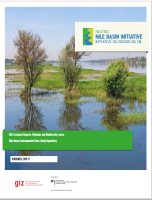Abstract
Over the last decade, flow in the Abay River (i.e. the Blue Nile) has been modified by operation of
the Chara Chara weir and diversions to the Tis Abay hydropower stations, located downstream.
The most conspicuous impact of these human interventions is significantly reduced flows over the
Tis Issat Falls. This paper presents the findings of a hydrological study conducted to estimate
environmental flow requirements downstream of the weir. The Desktop Reserve Model (DRM ) was used
to determine both high and low flow requirements in the reach containing the Falls. The results
indicate that to maintain the basic ecological functioning in this reach requires an average
annual allocation of 862 Mm3 (i.e. equivalent to 22% of the mean annual flow). Under natural
conditions there was a considerable seasonal variation, but the absolute minimum mean monthly
allocation, even in dry years, should not be less than approximately 10 Mm3 (i.e. 3 7 m3 sÐ1).
These estimates make no allowance for maintaining the aesthetic quality of the Falls, which are
popular with tourists. The study demonstrated that, in the absence of ecological information,
hydrological indices can be used to provide a preliminary estimate of environmental flow
requirements. However, to ensure proper management, much greater understanding of the relationships
between flow and the ecological condition of the river ecosystem is needed. Copyright



